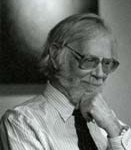 April 15 2004
April 15 2004
Dactyl celebrates the release of A New Theory for American Poetry: Democracy, the Environment, and the Future of Imagination by Angus Fletcher.
Angus Fletcher’s previous contributions to the study of poetics have provided us with, among other valuable insights, a comprehensive account of allegory as a primary mode in literature and an intensive meditation on the shape of thinking in poetry. With his latest offering, he presents a formal description of American poetry as American, that is, not descendant from English Romanticism but self-created. He defines a new poetic genre that is independent and self-governing. In this sensitive and comprehensive study, Fletcher draws upon contemporary ecology and the complexity sciences to illustrate and compare his sense of American poetic form, its origins and mechanisms, to natural phenomena. Focusing on description, metonymy, and metalepsis, Fletcher’s key poet are Ashbery, Whitman, and Clare.
Of the three aspects of this theory, Democracy, the Environment, and the Future of Imagination, the second is most fully explored. Fletcher praises what he calls the “environment-poem” for its distinctly American resistance to the Platonic forms. With the same unassuming style that–surprisingly, refreshingly–characterizes his other very learned writings, Fletcher faces the difficult task of defining a new genre and makes its features clear: Environment-poems are not about the things that make up environments; they are environments. Poets of this genre are not like cartographers representing an environment as a place, so much as like choreographers representing movements in space. The actions of singular heroes are less important than “the aggregate relations of all participants” (123). Art is “commonly and wisely thought to depend less on factual reference to things in the world, and more upon our imaginative relationship with those things and references” (176), and environment-poems seek emergent rules governing these relationships, even as they appear chaotic. In the complexity sciences, as in environment-poetics, because emergent laws are abstractions of relationships rather than of objects, the study of one system can lead to an appreciation of other systems that share similar dynamics, even though they may be about very different things. Hence, observes Fletcher, the pattern of the poem can also be a pattern of the poet’s interiority. The author “emerges . . . through a crisscross motion within the mental space correlated to some physical space the poem describes. For the outer world in its letter gives the coordinates of the inner world with its thoughts” (120). While Harold Bloom contends that Whitman’s goal is to project his own selfhood, “tallied” or counted as a finally transcendent reality, Fletcher sees Whitman exploring a pattern of environmental interaction. The self has power only as an agent within the larger ensemble, a coherence the poetic form must mirror through an intentionality “clearly in the work, not in the maker alone” (206).
The environment-poem idea recalls age-old theories concerned to argue that art is necessarily holistic, irreducible, or organic. Such aesthetics derive ultimately from Presocratic philosophy, where the world can only be understood as living form whose categories are founded, as an environmentalist might say, upon a Gaian theory of mind. The whole is greater than the sum of its parts because the relationship adds something more, something lost when the system is broken down and analyzed while static. What distinguishes Fletcher’s new theory is its tempered rejection of the quasi-religious Platonic form existing prior to or external to the poem, controlling from without. Fletcher shows how the environment-poem creates its own form; it arises from the interactivity of the parts. This “order out of chaos” idea–also age-old–has gained new purchase recently in the sciences, where it is referred to as “self-organization” and studied by non-linear dynamics researchers, who also reject classical reduction. Fletcher’s graceful analogies between poetics and physics are helpful and sensible, and they spring from an appreciation of art as a natural phenomenon.
Fletcher’s Ashbery, Whitman and Clare are not much like avatars of theory as it has developed during the last several decades. These three poets present no recognizable ideological “positions” or allegorical machinery. They continuously seek out figures of thought deriving directly from what the poems say about themselves. As Ashbery writes in “The System,” living without “prior concepts” is to live “in that labyrinth that seems to be directing your steps but in reality it is you who are creating its pattern” (qutd. in New Theory 200). The mention, in environment-poems, of self-organization, emergent laws, patterns and so forth, is not merely ironic, for the environment-poem does not, like the Romantic poem, refer to a Platonic Idea. Elaborating on Ashbery’s remarks in his Norton Lectures, Fletcher observes that Clare’s descriptions follow the arbitrary sequence of a walk through the countryside. He is a poet, like Ashbery, who “obeys a law of a continuously shifting center–not abandoning the idea of center per se as with some deconstructionists, but rather allowing a general denial of privilege to permit a paramount role to perception itself”
